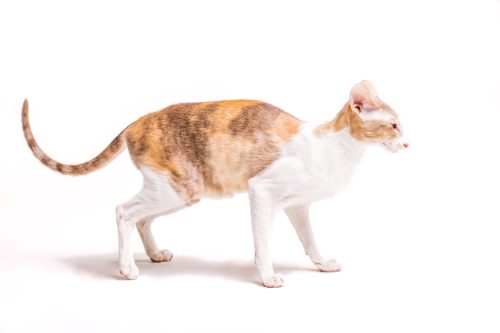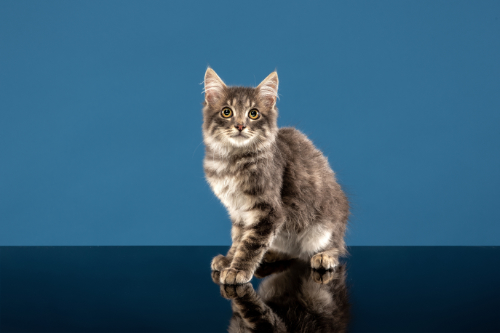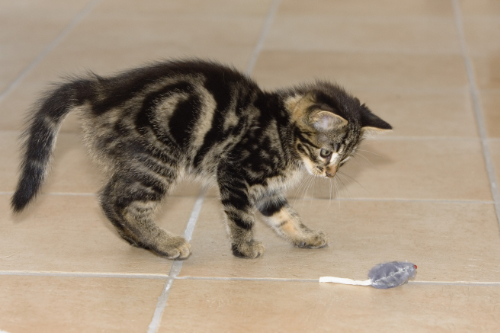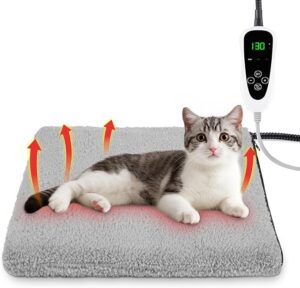What does it mean if a cat's back is arched?
Cats get an arched back when they suffer from abdominal pain, back pain, nausea, constipation, fear or stress, aggression, cold or playful behaviour. So, many possible causes if your cat has an arched back. And you as the owner want to know which one it is. Below we explain per cause what you can see in your cat to find out whether this applies to your cat.
Abdominal pain as a cause of an arched back in your cat
When a cat has an abdominal pain, it tightens its abdominal muscles. Since the muscles mainly run from the front to the back, the abdominal wall becomes shorter and the back slightly arched when the muscles are tightened. This gives the abdominal cavity a slightly different shape than normal, possibly causing the organs in the abdomen the cause for the pain to be pressed into a slightly different shape. This can relieve pain in some cases and make your cat feel more comfortable.
In addition to an arched or convex back, a cat with abdominal pain also has other symptoms. For example, they can be restless, whine or squeak a bit, purr excessively (yes, they don’t purr just for pleasure!), bite or lick their belly area. If they have pain in their gastrointestinal tract, they may also vomit or have diarrhea. In case you have a male cat, it is especially important to know whether he has urinated. Neutered tomcats in particular are susceptible to a blockage of the urethra that causes their bladder to become overfilled. This is extremely painful, but also life-threatening. So did your cat not pee for 24 hours and does it have a stomach ache? Then it is wise to have him assessed by your vet for a check-up. Especially if you keep seeing him walking to the litter box!

Back pain as a cause of an arched back in your cat
Cats with back pain also want to try to reduce the pain by sitting or lying in a position that is abnormal for them. In many cases, your cat will opt for an arched back. They move very carefully when they have back pain, prefer not to jump on or off anything and lie down very carefully. Often they also keep reclining because they cannot adopt a comfortable position. Back pain mainly occurs in older cats. But we also see this a lot in younger cats if, for example, they have had a (not too bad) collision with a vehicle.
Nausea also gives your cat an arched back
Nausea also causes your cat to tighten its abdominal muscles. Sometimes, in addition to the nausea, they also have some abdominal pain. By tightening the abdominal muscles, the back is slightly arched, which creates that arched back in your cat.
If your cat is nauseous, he will not want to eat as much and you can also sometimes see whole threads of drool are hanging out of his mouth. With severe nausea, he will even vomit.
Constipation as a cause
Constipation occurs when a cat can not pass his stool properly. The intestines will then stretch and that may be accompanied by some abdominal pain. In addition, the abdominal cavity becomes very full and by tightening the abdominal muscles, the shape of the abdominal cavity changes slightly, so that the pressure on the intestines can decrease. Your cat will then have an arched back.
A cat with constipation usually has occasional stools, but these are very hard. This makes it difficult for your cat to remove it from its intestines. You can help him with this if you will give him some laxatives like the one below.
Stress or fear also causes an arched back in your cat
Cats with stress or anxiety signal their whole body that they are in fully alert. In general, a cat has an arched back, its back hangs a bit lower than with a non-stressed cat. The tail can appear very swish or be pressed under its belly. When stressed, his pupils are fully round and dilated, while when a cat is relaxed pupils are a bit of a line. Don’t forget that you can also have quite a bit of stress from abdominal pain or nausea and that it is sometimes a combination. They can also hide as a result of stress. If you think your cat stresses easily you can start giving him Zylkène tablets. This causes the serotonin levels in his brain to rise. And that causes less anxiety.

Aggression and an arched back in your cat
Aggression in a cat is also partly accompanied by fear. His back will therefore be bent during aggression and he will also put his back hairs on end so that he looks extra impressive. He then holds his head a little higher in contrast to a fearful cat without aggression. He also hisses easily when something or someone who annoys him approaches him.
Cold as a cause
A cat that is cold will try to minimize its body surface that is in contact with the cold ambient air. That means that he folds himself into a ball with his legs and tail close to his body and a strongly arched back. We also see this posture with anxiety and stress, but in this case there is a relaxed posture. The muscles are therefore not all cramped as is the case with anxiety. If your cat is very cold, he will also be shivering a bit. You can try if it helps when you place him on a heated pad like the one below.
Playfull behaviour
When a cat is in a mad mood and wants to play actively, they often arch their backs. The rest of their body is relaxed and you can tell by your cat that he feels very happy. You see this especially when a cat plays with a ball or mouse. Even with a real mouse or bird, they often jump on top with their backs bent when they catch their prey.

Can cats have a hunch back?
Yes they can. But in that case they have this all the time. With a hunchback there is a misformed spine that is the cause of an arched back. In this case it is best to visit your veterinarian to find out what exactly is wrong with the spine in your cat and if it can be treated. A misformed spine is not something that happens a lot in cats. And in most cases that is does happen it is not causing any problems in his life and therefor does not need to be treated.
Combinations
As I mentioned in some points, it is also very possible that combinations are possible with an arched back in your cat. A cat with a stomach ache can also be nauseous, or an aggressive cat can also be anxious and, as can be seen in the photo above, playful behaviour can also be accompanied by some stress and anxiety. Just look at this kitten’s back and tail. The hair is puffed up and his pupils tend to be slightly enlarged. He finds that toy mouse quite exciting!
How to find out which of the above causes plays a role in your cat?
If you have had your cat for a while, you can undoubtedly see whether your cat feels comfortable or not. If this is not the case, it is necessary to find out what the cause of your cat’s arched back is.
Feaces and urine
First of all, you should check the litter box to see if your cat has pooped or urinated. This is difficult for cats that do their own thing, but if there is a litter box available, take a look in it. Hopefully you don’t have too many cats and you know whose droppings belong to which cat. Is the stool not too hard or is it diarrhoea? If you have a tomcat, it is especially important to know whether he has urinated and is therefore still able to urinate. When in doubt, clean the litter box so that you can see if he pees for the next 12 hours. That way, you’ll get clues as to where your cat’s arched back is coming from.
Food and water
If the defecation and urination all seem to have gone well, give your cat some food that he normally likes very much. Doesn’t he eat it? Then he may be nauseous and therefore has an arched back. Your cat must also want to drink something during the day. At least put it near him for a while so he doesn’t have to put much effort into it. In cat’s it is very important that they eat at least a little bit. Preferably half of their normal intake. This will prevent your cat from getting the disease “fatty liver“. Most cat’s will eat Hill’s Urgent Care if they feel nauseous.
Wait and see, but not too long
Does your cat walk like it’s walking on eggshells? Then there is a chance that your cat has an arched back because he has a back pain. You can watch this for a few days, but he shouldn’t seem to be in too much pain. A mild back pain will be resolved after a day or 2-3. In the meantime, check to see if his nail tips are worn or split. If so, he may have had an accident. If it bothers him a lot, it is important that you take him to your vet. This can determine whether further investigation is needed. For example an X-ray. But maybe a painkiller alone is also enough.
Visit your vet if in doubt or when it takes too long.
Did you not clearly found a cause for your cat’s arched back? If your cat doesn’t seem overly miserable, you can watch it for a day or two. In those days when you wait, he has to keep eating and drinking and you have to check whether he poops and pees. If he still has an arched back after those two days, it is better to visit your own vet to have him examined. Your vet can then give him appropriate treatment such as a painkiller or anti-nausea medication.
Good luck!
Hopefully you have found the answer to why the arched back in your cat happend and of course we hope he gets well soon. Good luck for the both of you.




